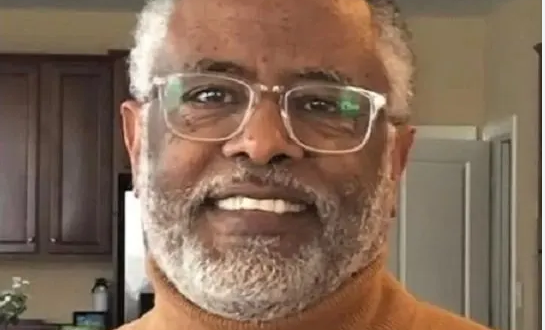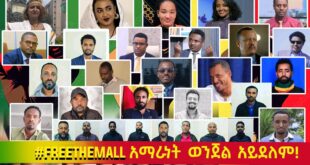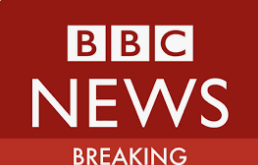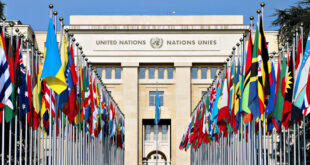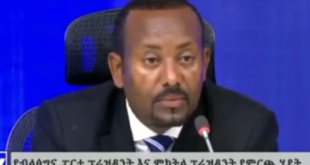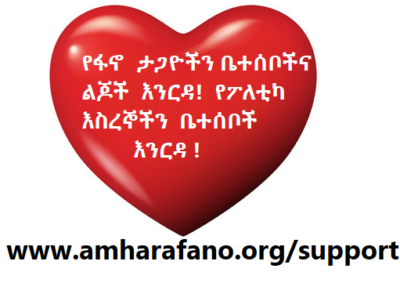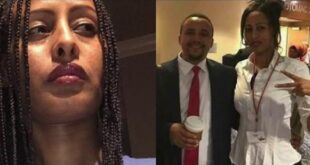Fano’s Current Realities: Challenges, Prospects & Next Steps
Yonas Biru (PhD)
April 5, 2024
“There will be times when people will find the use of force not only necessary
but morally justified… A non-violent movement could not have halted Hitler's
armies. Negotiations cannot convince al Qaeda's leaders to lay down their
arms. To say that force may sometimes be necessary is not a call to cynicism.
it is a recognition of history; the imperfections of man and the limits of
reason.”
Barack Obama, Nobel Peace Prize Lecture (2009)
“My 8-month-old child started crying. I heard an attacker say, ‘Look there,
look there …’ before they shot in our direction. They shot my baby dead. I
wrapped the dead body with some clothes I was wearing. My other child was
shot in her back; the bullet came out around her neck … I then pressed my
injured child against my chest, and I prayed to Allah to save her life.”
A Grieving Amhara Father, Today News Africa, June 2022
“The only force currently being disarmed/dissolved is the Amhara Special
Force (ASF), and the reasons are clear: It is not to dismantle an inherently
flawed security apparatus, but to leave the Amhara region vulnerable to
attack.”
Graham Peebles, a British Freelance Writer and Charity Worker
This article is prepared for a web conference on “Current Issues and Challenges of the Amhara
Movement) organized by an independent diaspora group to bring together people who hold
different perspectives on Fano’s strategic direction with the aim of building consensus. It
summarizes and builds upon two previous articles titled “The Fano Manifesto: A Proposal” and
2
“Critical Steps to Jumpstart Fano’s Stalling Momentum” that I published in August and
November 2023, respectively.
I. Imperative Premises
Fano is faced with a formidable tension between two end-goals. First is defending itself from
an existential threat, while being careful not to allow its uprising turn into a civil war. Second is
its principled position that a potential civil war should not mean allowing the government’s
genocidal agenda against the people of Amhara to continue.
The answer to the conflicting end goals is not a binary choice or, in more common parlance, an
either/or binding. Rather, it is a complex interaction where both factors influence decision.
Striking a delicate balance between the two is what will carry the day. The question that is
imposing itself on Fano is: How to delicately balance this tension between the two end goals?
The need to avoid a civil war requires it, and the nation’s political transformation depends on
it. Readers need to keep this in mind when considering the proposals put forth in this
presentation.
In the interest of providing a comprehensive presentation and contributing to Fano’s public
relations package, the article delves in great detail into the genesis of the Fano uprising. Those
who are familiar with the triggers of the uprising can proceed to page 9, Section III: Fano’s
Current Realities: Challenges, Prospects and Next Steps.
II. The Genesis of the Fano Uprising
The inserted pictures speak volumes that the Fanno protest movement is born out of survival
needs in the face of an existential threat against the people of Amhara. The pictures show (1)
mass demolition of residences, schools, and houses of worship by uniformed Oromo police
forces; (2) an exodus of forcefully
evicted people, totaling half a million
people; (3) little girls salvaging a desk
from their demolished school; and (4)
children left on the street with piles of
their family’s belongings with nowhere
to go. Understanding this level of
cruelty requires reckoning with the
existential war against the Amhara.
It is important to note from the outset
that the ongoing armed conflict is not
3
between Amhara and Oromo. It is between right and wrong. What is wrong is Oromummaa –
the political ideology of the Oromo national movement.
II.1. The Political, Economic and Demographic Disenfranchisement of Amhara
The economic, political, and demographic disenfranchisement of Amhara started during the
TPLF. It picked up pace and worsened during the Oromo-PP led government both in scope and
brutality.
Let us look at the population issue to drive the point home. In the 1984 population census,
Oromo accounted for 29.1% of Ethiopia’s population followed by Amhara at 28.3%. The
difference in population was 332,414 in favor of Oromo.
In the 1994 census, the first under the TPLF-led government, Oromo accounted for 35% of the
population. The corresponding figure for Amhara was 25.9%. The population difference
between the two skyrocketed to 4,898,228 in favor of Oromo.
In the 2007 census, the Oromo population accounted for 36.7% of the population. Amhara was
23.3%. Between 1984 and 2007, Oromos population changed from 29.1% (1984) to 35% (1994)
to 36.7% (2007) and to an extrapolated 34% (2023). In contrast, Amhara’s population shrank
consistently from 28.3% (1984) to 25.9% (1994) to 23.3% (2007) and to an extrapolated 22%
(2023).
Consequently, the population difference between Oromo and Amhara changed from 332,414
(1984) to 4,898,228 (1994) to 9,944,415 (2007) and to 13,626,137 (2023) all in favor of Oromo.
II.1.a. Political Disenfranchisement
This has significant political and economic implications. The 1994 census results that reduced
the Amhara population from 28.3% to 25.9% robbed the Amhara tribal lad over 20 seats in the
national parliament. If the current population estimate of 22% is used, Amhara will further lose
as many as 30 seats in future seat allocations.
II.1.b. Socio-Economic Disenfranchisement
The statistical depopulation of Amhara has adverse budgetary implications. For example, the
federal government budget subsidy for the 2023-2024 fiscal year shows 34% of the total
federal subsidy was allocated for the Oromo tribal land. Amhara got 21% based on the
systematically and grossly underestimated population.
4
The systemic under-allocation of federal budget appropriation has enormous socio-economic
consequences. During the TPLF’s era, one of its signature economic accomplishments was
infrastructure, particularly roads. According to a World Bank report revealed: “Remote and
economically lagging regions, and Amhara Region, saw lesser increases in road density… the
increase in road density was concentrated in certain regions, notably Addis Ababa, as well as
Tigray in the north of the country and in Oromia in the center.”
Another growth indicator the World Bank report used is “differences in the pattern of
nightlights over a given time.” This is important because such differences “are correlated with
changes in GDP.” The top three cities outside of Addis Ababa who registered relatively high
nightlights listed in the order of high to low are Mekele (Tigray), Adama (Oromo), and Awasa
(Northern People).
Access to health is another area of systemic social injustice. A 2005 world Bank report shows
delivery care by a medically trained person is the highest in Addis Ababa (69 percent) and the
lowest in the Amhara tribal land where it is “only three percent.”
According to the UN-OCHA report, in 2021, “about 80 percent of the land has been
cultivated across all Meher dependent areas; however, only about 50 percent has been
planted in Amhara, 80 percent in Oromia.” There are two reasons behind the significant
difference. First, fertilizer distribution is determined by population size. It should be noted
that the huge difference is not fully explained by population differential. The second
important factor is that when it comes to fertilizer distribution the government gives priority
to Oromo tribal land and denies the Amhara its fair share.
Furthermore, as Yohannes Buayalew (a member of the Amhara Region Parliament) stated:
There are five gateways into Addis Ababa. Two of which link the Amhara region to Addis
Ababa. The government routinely blocks these gateways to isolate the Amhara population.
Amhara traders cannot transport their merchandises into Addis and through Addis Ababa to
southern parts of Ethiopia. The parliamentarian is currently languishing in prison for
protesting the injustice.
Similarly, people from other regional states find it prohibitive to take their merchandise to sell
to people in the Amhara region and buy merchandise from them to take back to their regions
because of intermittent restriction of people and goods transportation from the Amhara
region. There is a systemic economic ostracization of Amhara.
II.2. The Oromummaa Ideology Targets the Amhara as a Strategic Adversary
5
The Oromummaa political ideology is championed both by Oromo-Shene (the armed wing of
the Oromo Liberation Front) and the Oromo-Prosperity Party (Oromo-PP). Thought the two
may vary in the degree and scope to which they embrace Oromummaa, both target the
Amhara as a strategic adversary to the foundational principles of its ideology.
Oromo-PP’s and Oromo-Shene’s leaders are on the record asserting their goal is to resurrect
and institutionalize the 16 th century Oromo governance system of Gadaa throughout Ethiopia.
The President of the Oromo tribal homeland (Shimelis Abdisa) has publicly announced the
future of Ethiopia is “The Gadaa system.” He has further revealed that as part of this grand
strategy the “Prosperity Party is built in such a way to advance the interest of Oromo. The head
of the Party will always be an Oromo or an Oromo plant.” He has also made it clear that the
Oromo government is “spending billions” to institutionalize Gadaa.
A detailed strategic plan of the Oromization of Ethiopia is provided by Oromummaa
intellectuals in a report titled “We Need Modern Version of the OLF With High Confidence
Politics.” The strategy paper declares the ultimate goal of Oromummaa is to “slowly, but surely,
transform Ethiopia to Gadaa democratic Ethiopia, i.e. de facto Greater Oromia.”
In 2019, Jawar Mohamed put flesh on the bones of the Oromummaa doctrine, stating: “The
nation’s fate is in our hands. This is our opportunity now. Yes, it is our time. We will implement
our agenda without paying attention to the cacophony.”
This is not a slip of the tongue. At bottom, Jawar’s February 2023 manifesto was about making
sure the levers of political power will not slip out of the hands of Oromo. His manifesto was
written long after he was released from prison. Oromummaa’s dual objective is creating a
hegemonic Oromia and getting “Ethiopia Out of Oromia,” a slogan Jawar popularized. In a
sardonic twist of irony, Oromo political zealots (idiots may be more appropriate) aspire to
create a hegemonic Oromo across Ethiopia. In the meantime, they want Ethiopia to have
nothing to do with their beloved Oromia.
What makes Oromummaa dangerous is that its implementation is driven by the 16 th century
Gadaa military tradition (Mogassa). Mogassa is a forced assimilation of other tribes into the
Oromo tribal empire.
In “The Oromo of Ethiopia, 1500-1850,” Mohammed Hassen, a renowned Oromo Historian and
a representative of Oromo-Shene in international meetings, documented the Gadaa conquest
and forced assimilation in disturbing details as follows.
6
The Oromo warrior classes which fought with frenzied determination
astonished the elite of the Christian and Muslim states and terrorized the
populace. When new areas were attacked, the men were killed, and animals
were captured. Probably the killing was intended to spread terror among the
resisting population while the taking of cattle booty was to enrich themselves.
Enslaving the vanquished people was an economic as well as military necessity.
Gadaa warriors are the devils who attack in the evening… Most of the
conquered people who had earlier submitted with little or no resistance,
found that they were no longer equal members of a clan within which they
were incorporated, but slaves who were used as gifts and commodities for
sale.
In another book titled The Oromo and the Christian Kingdom of Ethiopia: 1300-1700,
Mohammed described the Mogassa terror and slave trade as “The Oromo genius for
assimilation of non-Oromos, defeated or otherwise.”
It is the terror and savagery of Gedaa mindset of centuries past that the Oromo-PP and
Oromummaa ideologues consider “genius” and wish to resurrect and institutionalize in the
21 st century Ethiopia. In pursuit of their goal, they see the Amhara as a counter force. Thus,
their demonic mass murder and mass eviction of the Amhara people.
Numerous cases of mass murders of innocent and defenseless Amhara civilians by
Oromo-Shene are headlined by the international media. Examples include: “more than 200
Amhara people killed” (The Guardian); and “heavily armed assailants shot and killed about
400 Amhara civilians, including many women and children” (The Human Rights Watch).
International media headlines about atrocities perpetrated by Oromo-PP led government
include: “Aerial strike on Ethiopia church grounds kills eight” (Reuters); “Ethiopia 'using
Turkish drones to bomb civilians'” (The New Arab); “Evidence of Drone Strikes Inside Civilian
Areas” (New Lines Magazine); and “Drone strike kills 30 Amhara civilians” (APA News).
Headlines flagged by international organizations include: “Active Genocide Alert in Amhara
Region” stressing “The Amhara are in a perilous discursive position that could easily
devolve into genocide” (The Lemkin Institute for Genocide Prevention); and “Ethnic Violence
against Amhara People” (Appeal by The European Center for Law and Justice’s to the United
Nations).
7
Even the Prime Minister’s cabinet members have started to speak up at a grave risk to
them and their family. State Minister of Peace and former spokesperson of the Oromo-PP
(Taye Dandea) condemned the PM publicly as “a savage playing with human blood". He was
arrested and his wife and children were thrown out of their residence.
Another state minister of peace (Seyoum Mesfin) fled the country and added his voice to
the chorus of alarm bells, stating: “The Abiy Administration lacks character of a
government, and it is isolated and hated by the public”
Furthermore, the Ethiopian Human Rights Commission (EHRC) documented in great detail
111,118 families were forcefully displaced from the outskirts of Addis Ababa (the so-called
Sheger City) by the Oromo government. The injustice was done with the full knowledge
and approval of the Prime Minister.
The Ethiopian Statistics Service suggests that one-quarter of households are headed by
women and the average household size is 4.6 members. This means well over half a million
people were forcefully displaced by Oromo-PP. Of which over 100,000 children and elders
were headed by women.
One of the Prime Minister’s Cabinet-Rank Senior Advisors had it right when he warned the
world on April 3, 2023 stating: “Today’s Ethiopia is at a juncture similar to that of Rwanda
when it found itself at the dawn of genocide.”
The Prime Minister has made the threat of genocide in no uncertain terms. In 2021, he
accused the Amhara of conspiring to overthrow his government and threatened them
stating that they would see “the slaughter of hundreds of thousands of people over night.”
In 2023, he upped his threat, stating “the consequence will be deadlier than the red terror
in the 1970s.” According to the African Union, “more than 700,000 people were killed”
during the red terror.
II.3. Anti-Christian and Anti-Islam Oromummaa
Oromummaa targets the people of Amhara not only because of their tribal heritage but
also because of their religion. The overwhelming majority of Amharas are either Orthodox
Christians or Muslims. The Oromummaa ideology is grounded on Waaqeffanna – a
traditional Oromo religion.
In an article titled “Promoting and Developing Oromummaa, Professor Asafa Jalata (the
Godfather of Oromummaa) characterized Christians and Muslims as Ethiopian “Empire
8
Builders.” He describes Mosques and Churches as “Colonial Institutions.” Furthermore, in a
widely published article, he claimed “The Ethiopian colonial terrorism and genocide that
started during the last decades of the 19th century still continue in the 21st century.” He
accused the processes of the “Abyssinianization and Christianization” of Oromos of being a
racist endeavors.
On September 6, 2023, an international Orthodox group reported, “Christian homes and
businesses were destroyed by extremists after a campaign” that accused Orthodox
Christians of being sorcerers. On December 23, 2023, the same international group
reported about “targeted Killings of Orthodox Christians Continue in Arsi” region of Oromia.
As the U.S. Office of International Religious Freedom has reported, government police
forces are part of the Orthodox Christian mass murder, going as far as opening fire on
peaceful worshipers “during an Epiphany parade.”
The thirst for revenge and vengeance is not only palpable, but also profoundly aggressive.
During the second half of 2023 alone the Oromo government demolished over 200
Churches and Mosques. Additionally, over 600 more churches and mosques are marked
for demolished.
Today, Ethiopia has become a country where anti-Christian fanatics “slit open the belly of a
9-months pregnant woman, rip her fetus out, and hand the lifeless child to the dying
mother.” As APA News documented “28 Christians were murdered in brutal killing spree by
Oromo armed militants on 23 November 2023.”
There is nothing sacred in the belief system of the two destructive forces of Oromo-PP and
Oromummaa. Anti-Christian forces parade Orthodox Christian priests on the streets of
Oromo cities with dead black chicken hanging on his neck. The black chicken signifies the
allegation that Christians are black magicians.
Police officers slap priests and beat up imams in public, They kill religious leaders, and
throw teargas at Orthodox Christians while they pray and sing hymns of praise to God. This
is done not in Oromo-Shene controlled regions, but in major Oromo cities in full sight of
government officials. The criminal actions are taped and widely circulated with no action
taken.
In the face of such atrocities the world has failed to pay heed to Pope Francis’ Clarion call to
“Pray or persecuted Christians in Ethiopia.” Ignored also is the Council on American-Islamic
Relations’ (CAIR) appeal to the US government to “take concrete actions to prevent the
government of Ethiopia from demolishing that nation’s mosques”
9
In another publication, the Godfather of Oromummaa claimed: “The Abyssinian/Ethiopian
government massacred half of the Oromo population (5 million out of 10 million) and their
leadership during its colonial expansion” The so-called colonial expansion was during
Menilik’s era (1889-1913).
In 1990, the estimate for Ethiopia’s total population ranged from 4 million (Brilliant Maps)
to 10.7 million (Central Statistical Agency). According to the 1984 national population
census, the Oromos account for 30% the total population of Ethiopia. This puts the Oromo
population in 1900 somewhere around 1.2 million (using the 4 million total population
figure) or 3.21 million (using the 10.7 million estimates.)
The UN, the most authoritative source for international population census, does not have
an estimate for Ethiopia for 1990. The earliest estimate it has is for 1950, which is 18
million. That puts the Oromo population in 1950 about 5.4 million. Asafa Jalata’s murder of
5 million in 1900 represents an utter lie to foment hate and violence against Amhara to
which Emperor Menilik belongs.
His lies did not stop with fabricated genocide. He added: “Menelik controlled slave trade (an
estimated 25,000 slaves per year in the 1880s); with his wife he owned 70,000 enslaved
Africans; he became one of the richest capitalists.”
Such fabricated allegations by the most authoritative Oromummaa intellectuals are neither
innocuous nor inconsequential. Of recent, the atrocities have taken a new turn to
indiscriminate drone attacks against civilian Amharas. The focus of the drone attack is the
province of Gojam, widely considered as the bible belt of Ethiopia located in the Amhara
region. The following selected reports were published since August 2023. There are many
more similar reports.
“Human Rights Watch says Ethiopia’s army ‘summarily executed’ several
dozen civilians in the country’s north-western Amhara region in January.” (Apr
4, 2024).
“Dozens of civilians have been killed this month by drone strikes and house-
to-house searches in Ethiopia's Amhara region” (Oct 30, 2023)
“Air strike kills at least 26 in Ethiopia's Amhara region” Le Monde (Aug. 15,
2023)
10
The UN voiced concern about "the devastating impact of drone strikes and
other violence on the population in the Amhara region" Voice of America
(Nov. 17, 2023).
Modern Tokyo Times took note that “New artillery and drone strikes killing
civilians are a continuation of intimidating the Amhara” (December 7). The
report revealed drone targets included a primary school, bus stations and an
ambulance carrying crucial medical supplies.
II.3. Beyond Mere Survival
As Ethiopians, Fano fighters believe the people of Amhara have the right to economic
freedom and equal access to resources that the federal government controls. There is
ample evidence showing that the Amhara is economically disenfranchised in ways small
and large.
As a 2023 UNDP report revealed the nation’s key macroeconomic parameters are “in the
danger zone” and its “fiscal space has essentially disappeared. In 2023, defense and debt
servicing expenditures account for more than a fourth of the total budget.”
Where is the budget going? The government has been acquiring Chinese-built 155 mm
SH15 wheeled, self-propelled howitzers, according to The Defense Post and Military Africa.
This is a new addition to the Prime Minister’s collections of advanced weapons from
Turkey, Iran, and North Korea.
The rest of the budget is spent on Prime Minister’s new palace with an opulent environ at
the cost of $15.3 billion (14 percent of Ethiopia’s GDP). Le Monde described the project as
“pharaonic taken by delusions of grandeur” glamoured up with a waterfall, three artificial
lakes, a zoo, and luxury villas. In comparison, the Kremlin is estimated to cost 1% of
Russia’s GDP. The Élysée Palace in Paris and the White House in Washington are estimated
to cost 0.0045% and 0.0002% of their respective GDP.
As the Prime Minister goes on a Dubai-inspired binge for flashy vanity projects and state of
the art drones, 22 million Ethiopians need international food aid of which 4.6 million are
internally displaced living in makeshift camps. More than 2.3 million children are out of
school, as they wait for the reconstruction of schools destroyed by the war. Furthermore,
three million people have slipped below the absolute poverty line.
11
This, in a nutshell is the genesis of the Fano armed uprising. Anybody who have studied the
Oromummaa political theology would understand raising arms was Fano’s choice of last
resort for survival.
The Prime Minister’s culture of betrayal, habitual lies and countless broken promises make
it impossible to assume the atrocities against the Amhara will stop if Fano puts its arms
down. The survival of the people of Amhara and the protection of Orthodox Christianity
and Islam demands armed resistance.
III. Fano’s Current Realities: Challenges, Prospects & Next Steps
To date, Fano has registered phenomenal military milestones. The size of its all-volunteer
fighters has swollen, rivaling in number the government’s military forces. It has successfully
repelled repeated government offensives. It has defeated government forces in many
fronts and captured significant light and heavy weapons. Most of the rural areas and small
cities in the Amhara tribal land are under Fano control.
No doubt that its successful military achievements has forced government to stop
government-led displacements in the Oromo tribal land. A planned displacement program
in Nazareth (a city the Oromo-PP led government calls Adama) has been temporarily
halted.
No one forgets Shimelis threat on the record that “no power on earth or heaven will stop
his government from demolishing the said 600 churches and mosques.” Fano has forced
him from going ahead with his threat. The demolition project has been temporarily halted.
Despite phenomenal milestones Fano has crossed, a closer examination of current realities
reveals critical fault lines that has prohibited it from reaching higher milestones. This is
attributable to the lack of unity of purpose across the disparate Fano forces.
At the core of this problem is the failure to develop a common political agenda and strategy
along with a clear and unified end goal with concomitant roadmap that is adoptive to
dynamic changes.
As a matter of practical necessity, Fano leaders need to pay heed to the fact that, in and of
itself, having morally, and politically justified cause for an armed uprising does not lead to a
political victory. This is so because military strength is a necessary condition for political
12
victory, not a sufficient one. Strategic alignment across the movement’s political and military,
domains is imperative to ensure all cylinders are firing in a coordinated fashion.
The danger with the current situation is that the movement can reach a tipping point on
the military front, while critical political variables lag behind both in terms of establishing
national political consensus and a unified leadership architecture. T
he military tipping point may be precipitated by the collapse of the government, owing to
economic meltdown. It may also be triggered by mass desertion of Amhara militia and
special force in protest of escalating government atrocities against civilians.
Misalignment between political and military strategies and operations can potentially lead
to serious consequences. Chief among them is the risk of civil war. Even worse, the threat
of warlordism within Fano forces cannot be ruled out.
Why have Fano leaders failed to form an all-inclusive political agenda and a robust and
unified Fano political architecture? The problem is attributable to four sources of
contention
First, some Fano leaders refute the need for a Fano manifesto that lays out the
movement’s political agenda, strategy, roadmap, and end game. They rally behind “መነሻችን
አማራ፣ መድረሻችን ኢትዮጵያ” slogan that means everything and nothing at the same time. Its loose
translation is: “We start with Amhara and end up with Ethiopia”.
Second, some Fano groups are vehement that there is no victory short of removing the
Oromo-PP led government, while others believe that if certain conditions are met a
negotiated settlement is the most viable and least costly way forward.
Third, there are differences in opinion about the timing of forming coalition with forces
outside of the Amhara tribal land. Some groups work with the belief that such a broad
coalition can wait until Fano achieves victory. Others believe such a coalition must be
formed as a matter of urgency.
Fourth, there is the universal political source of contention: Power Struggle. Power struggle
is not necessarily a bad thing in and of itself. It is also unavoidable. What is important is
making such power-centered conflicts manageable. Power contentions are manageable if
there is an agreed upon consensus political agenda, strategy, roadmap, and end goal. This
is explained in section III.5. below.
13
Fano’s powerbase is the people of Amhara. Its military operation cannot rely solely on
grievances against government atrocities. It requires a political roadmap and clear end goal
to inspire the people’s confidence and sustain their support. It is time for the Fano
enterprise and its support ecosystem to pause, reflect, retrospect and take a midcourse
correction to bring its political and military means into balance. In this regard, the issues
need to be addressed with absolute urgency.
III.1. The Need for a Fano Manifesto
The political space cannot be governed without a political agenda, concomitant strategy
and a robust roadmap. The above-noted political slogan “መነሻችን አማራ መድረሻችን ኢትዮጵያ” is not
a substitute for a strategic political manifesto. There is disagreement on what “መነሻችን አማራ”
means. The meaning of “መድረሻችን ኢትዮጵያ” is even more contentious.
For example, as noted above, some Amhara groups are open for a negotiated settlement.
Others are adamant about overthrowing the government. Which Amhara is “መነሻችን?”
Furthermore, there are Ethiopians who swear by the current Constitution. In the meantime,
there are others who see the Constitution as the source of the nation’s political cancer.
Which Ethiopia is መድረሻችን?
There are two primary reasons behind the failure to develop a unifying manifesto. On the
one hand here are some within the Fano enterprise who believe the focus should be on the
military front. They see political dialogues and debates as distraction. On the other hand,
there are extremist forces who stand in the way of developing consensus and push their
stealth agenda behind a vaguely constructed slogan.
The first problem is a relatively easy one to solve by delegating the task to a council of
experts with repute, proven prudence, and strategic vision. This will free Fano leaders to
focus on the military domain without distraction. The second problem is harder to crack
because extremist forces standing in the way of a consensus political agenda and strategy
that will undermine their extremist agenda.
Who are Amharas extremists? They are an off-grid and high-bandwidth network of activists
who aim to dial back the time to when the Amhara played a dominant role in state politics.
The network’s doctrine coalesces around Amhara nationalism at its nucleus from whence a
unitary mindset radiates outward and expresses itself as a national identity.
The network has neither a written manifesto nor an organizational platform. Instead, it
pushes a passive-aggressive strategy to take the Ethiopian political center stage, using
14
grievance politics both as the power cylinder and transmission belt of its political
machinery.
That is why they say their political agenda is to stop the governments genocidal war against
Amhara and this is universally accepted agenda across the Amhara tribal land. But his is
disingenuous because the political agenda is not only to stop a genocidal threat but also to
bring about pollical change. The form and substance of the change need to be discussed to
develop a consensus agenda and strategy.
III.2. The Need for a Clear End Game
The current war between the government and Fano signifies a grim situation characterized
by a glaring mismatch between desired outcomes and hard realities. On the one hand, the
government’s war is not guided by a military strategy or political logic. Rather, it is driven by
a narcissist cum psychopathic Prime Minister who is driven by Oromummaa and relies on
fake evangelist prophets who assure him of a divine victory.
On the other hand, the sad reality is that Fano’s military offensive is stalled or at the very
least lost its initial momentum. This is due in part to the fact that the military uprising is
conducted in a political vacuum. The dynamic interaction of such a reality in the face of a
reckless Prime Minister is highly likely to degenerate into a destructive state of entropic
chaos from which neither the government nor Fano can emerge as a strategic winner.
What Does Political and Military Victory Mean? Fano needs to define its strategic
political and military end goals. Is it a change of government that involves abolishing the
Oromo-PP led political leadership? If so, what is entailed? Unseating the Prime Minster or
also dissolving the Parliament and overhauling the Constitution?
Is a change of governance acceptable, if institutional guardrails are created to reign in the
Prime Ministers God-like omnipotence and satanic malevolence? If so, what are the
preconditions? The substance of these questions have significant bearing on the success of
achieving Fano’s desired goal of ending Oromummaa’s drive for Oromo hegemony.
The same extremist forces who are against developing a consensus manifesto are against
pursuing a clear and consensus-based end goal. Their goal is unseating the Prime Minster,
dissolving the Parliament, and overhauling the Constitution. They know this will not win the
support of a large segment of the people of Ethiopia. Rather than making the merits of
their case and win the confidence and support, they aim to achieve their goal by force.
III.3. The Urgent Need for a Coalition with Non-Amhara Forces
15
The thinking that Amhara will form a broad-based coalition after it takes power is
wrongheaded for two reasons. First, the road to success is shorter if a broad coalition is
formed. Second, if Amhara does not see the value in listening to, and seeking input from,
other tribal homelands before victory, how can it be trusted to form a democratic coalition
government after it grabbed the levers of power?
Above all, it is important to realize that Amhara may have the right to make political
decisions regarding its tribal homeland. It cannot decide national matters such as removing
the government on behalf of others. If it believes overthrowing the government is
necessary, it needs a buy-in from opposition forces outside of the Amhara tribal land. Fano
leaders cannot assume their agenda, no matter what it may be, is the agenda for all
Ethiopians until it is discussed and consensus is reached.
Ethiopians remember there was the EPRDF (led by Tigrayans), EPRDF 2.0 (led by Oromos)
and are not keen to give EPRDF 3.0 (led by Amhara) the benefit of the doubt. The
perception that the Oromo, Amhara, and Tigray political class want to dictate their views on
others is widely held. This is the time to break that perception and the Fanno Movement
must do it both for its own and Ethiopia's sake.
III.4. The Need to Win the Confidence and Support of the International Community
Its sheer population size and its being the primary target of atrocities makes the Amhara
the epicenter of the opposition enterprise around which anti-government forces from all
tribal lands can coalesce. This requires winning the confidence and support of non-Amhara
forces through an inclusive dialogue and broad consensus building.
The international community understands the Prime Minister is pushing the country into a
disastrous civil war and destabilizing the entire Horn of Africa. The Fanno movement must
present itself as a nucleus and catalyst for a credible and broad-based opposition.
Fano must show that it has a forward-looking vision anchored in political maturity,
diplomatic temperance, and deference to plurality. Its military advances must be guided
and restrained by confidence-inspiring political guardrails. This will help it to become a
transformative and stabilizing force. In this regard, having a political agenda with a
concomitant strategy and robust national and international PR narratives will help it to
leverage the international community.
Currently, there are numerous Fano support groups in the diaspora who are representing
disparate Fano forces. Each diaspora group approaches the international community with
16
different talking points and conflicting requests for help. The opinion that the US
government has about Fano is: It is hard to know whom to talk to and what their collective
agenda is. This must change immediately.
III.5 The Need to Mitigate Power Struggle Within Fano
Having a unified political agenda along with concomitant strategy, roadmap, and end goal
is important to mitigate power struggle for two reasons. First, it will deny power thirsty
leaders the opportunity to hide their personal power-driven agenda behind “strategic
political and military differences.”
Second, it will help to build a critical mass around a common agenda and alienate extremist
forces who neither engage in dialogue to persuade others, nor consider an alternative path
outside of their view. A consensus-based critical mass will leave them with a choice to
either be a part of the common agenda and strategy or get marginalized.
IV. The Chicken-or-Egg Conundrum
The chicken-or-egg is an age-old idiom that describes a sequencing dilemma involving two
intertwined issues where each issue’s success depends on the success of the other being
done. Fano is faced with the dilemma of determining how best to achieve unity of
leadership and unity of purpose. Unlike the chicken-or-egg conundrum, the Fano problem
is not necessarily a sequencing problem, though one may require more energy than the
other.
Since the explosive emergence of diverse Fano uprising, enormous efforts have been made
to bring different Fano leaders together. The efforts of the so-called Concerned Amhara can
be mentioned as an example. The effort was misguided and ended with frustration. See my
articles “The Concerned Amharas are Undermining the Fano Movement” (November 2023).
The difficult issue of how to bring about a system that will transform the spontaneous
uprising into a more organized form of struggle remains unanswered. It would be
intellectually dishonest not to be candid about the source of the problem. The problem is
with the Amhara intellectual class.
Rather than being opinion leaders and consensus builders, Amhara intellectuals at home
and abroad fall into one of the following three groups. The first group has made itself a
groupie of one Fano faction or another, thereby becoming part of the problem. The second
group is engaged in እድር-ወ-ፅዋ traditional mediation that relies on the science of አንተም ተው
17
አንቺም ተይ doctrine of እርቅ between Fano factions. The third group stands on the sideline as a
disinterested spectator.
It is abundantly clear that the primary sources of the problem are some Fano leaders who
see themselves as entitled or whose groupies view them the chosen. Trying to convince
them that they are neither entitled nor chosen is a waste of time. It is long past time to
have a candid dialogue that is not restricted by the Ethiopian culture of nicety.
V. Some Thoughts on the Way Forward
Unity in Fano leadership and unity in purpose are matters of extreme urgency. The Fano
problem is not necessarily a sequencing dilemma. It is not restricted to a binary choice.
The goals of unity in leadership and unity in purpose can be perused simultaneously. But
this requires making sure one will not be a prisoner of the other. For example, if there is a
Fano group that insists on being the leader of all Fanos, that group needs to be excluded
from the dialogue. The focus should be on those who genuinely want to work together. As
time passes, those who were reluctant or outright against a consensus-based unity of
purpose and leadership may reconsider their position and join the consensus agenda and
strategy.
If unity in Fano leadership and unity in political agenda and strategy cannot be achieved
simultaneously, priority must be given to the latter for various reasons. The absence of a
unified political agenda and strategy makes it nearly impossible to foster unity in
leadership. In contrast, unity in political agenda and strategy can sustain the Fano
movement even if there is no unity in leadership, provided open hostility is avoided and
different Fano groups operate in their respective lanes. This is a second-best solution.
What do I mean by avoiding open hostility and keeping Fano groups in their respective
lanes? It is easier to explain this with an example. Let me first present the lay of the Fano
land.
The Amhara tribal land is divided into four regions: Shewa, Wello, Gonder Gojam. In each
region, the Fano enterprise is organized in four hierarchical levels: (1) የጎበዝ አለቃ –
foundational unit, (2) ብርጌድ – a division consisting of many foundational units, (3) ዕዝ – an
amalgamation of divisions to form a command in each of the four regions mentioned
above, and (4) የአማራ መከላከያ ሃይል – Amhara Defense Force. The problem is at level 3. To date,
only Gojam has managed to form ዕዝ – Command.
18
In Shewa, there are two forces operating independently in different parts of the region. If
the two cannot find it possible to join their forces under a common command, the best
thing they can do is to carry on their operation in their lane. Problem arises if one of the
two unilaterally declares itself to be a regional command. This undermines the other group
and may be seen as a hostility move.
Moving forward priority should be given to the following action plan.
1. Build a consensus on the endgame. Is change of government a must? If so, how does
Fano mitigate the risk of a civil war? If change of governance is viable, what are the
preconditions that the government must meet? This is a thorny issue. It is also the most
paramount issue. If success is met in tackling it, it makes the challenge to address the
remaining issues less daunting.
2. Establish a minimum common political agenda, layout a strategic, flexible, and adoptive
roadmap that will guide the movement to achieve its end goal. It may not be possible to
bring every Fano force on board. But a critical mass can be established. Operationally, it
is easier to create a critical mass and build on it to bring all Fano forces together, rather
than spending energy to bring all leaders to the table in one go, when there are Fano
leaders who are gaming the process.
3. Establish a forum to form a broad coalition with all stakeholders inside and outside of
the Amhara tribal land. Building a broad consensus on matters of general principles.
Restraining from thorny issues and focusing on a minimum common agenda can help
to get the ball rolling. This may be done with the help of diaspora support groups and
mediation/arbitration facilitators. Success in this area can broaden the national support
base and attract the attention of the international community.
4. If establishing a unified Fano front proves unattainable in the short term, then a
second-best solution is establishing some binding constraints to refrain Fano leaders
from undermining, unduly interfering or conflicting with other Fano groups. The
second-best solution can work if there is a common platform with strategic roadmap
and a shared end goal.
5. Finally, Fano must deal with the Ethiopian culture of nicety, and candidly and publicly
reject those who claim Fano has Manifesto. They are either lying, or do not want to have
a consensus Manifesto because they fear it will crowd out their extremist agenda. Or
just as likely they have no clue about the paramount importance of the alignment of
unity in leadership and unity in purpose. Unity in purpose cannot be achieved without a
19
political agenda and a concomitant strategic roadmap and a clear end game. That is
called Manifesto. Manifesto is what presents a group’s vision, mission, direction, and
roadmap to win broad confidence and support in the furtherance of its political agenda.
PS: Let us dare to be honest. Fanos who are sacrificing themselves demand no less. The
Oromummaa ideology is architected by some of the world’s most idiotic clowns whose
body politics is possessed by the demons of 16 th century Mogassa soul. Sometimes I
wonder if God wants to punish Amhara. Why else would he over-populate its intellectual
class with useful idiots who are outsmarted, outsang, outdanced and out-አቱቶ-ቡቱቶized by
the world’s most idiotic clowns whose body politics is possessed by the demons of 16 th
century Mogassa soul.
ካጠፋሁ ይቅርታ. To err is human, to forgive is divine.
 Amhara Fano Supporters – የአማራ ፋኖ ደጋፊዎች Amhara Fano Support Website – የፋኖ ደጋፊዎች
Amhara Fano Supporters – የአማራ ፋኖ ደጋፊዎች Amhara Fano Support Website – የፋኖ ደጋፊዎች

